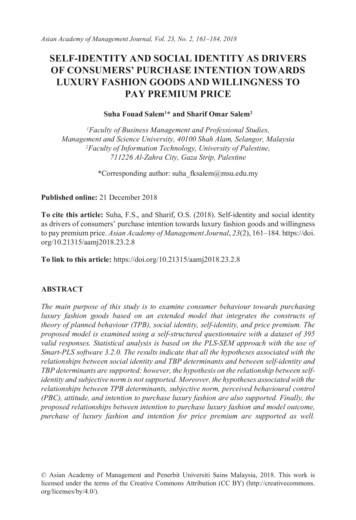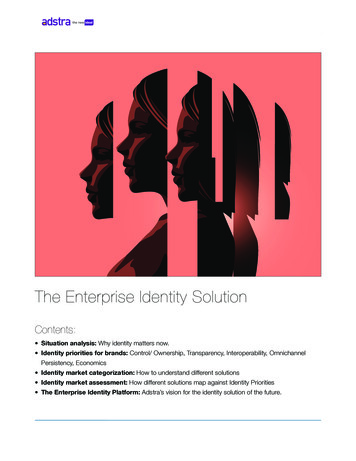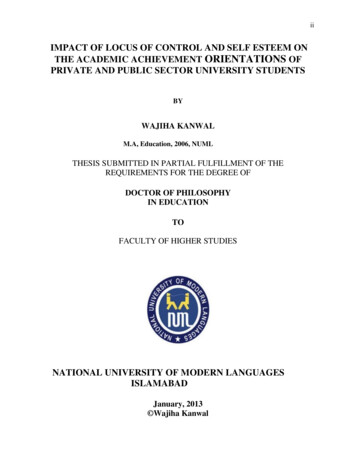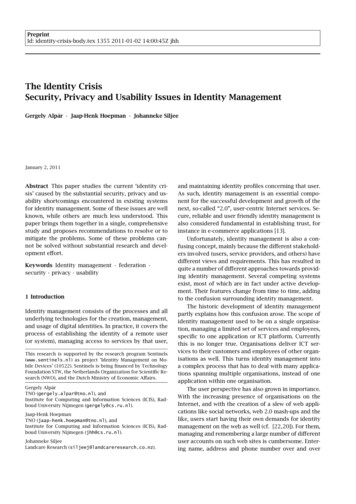
Transcription
Asian Academy of Management Journal, Vol. 23, No. 2, 161–184, 2018SELF-IDENTITY AND SOCIAL IDENTITY AS DRIVERSOF CONSUMERS’ PURCHASE INTENTION TOWARDSLUXURY FASHION GOODS AND WILLINGNESS TOPAY PREMIUM PRICESuha Fouad Salem1* and Sharif Omar Salem2Faculty of Business Management and Professional Studies,Management and Science University, 40100 Shah Alam, Selangor, Malaysia2Faculty of Information Technology, University of Palestine,711226 Al-Zahra City, Gaza Strip, Palestine1*Corresponding author: suha fksalem@msu.edu.myPublished online: 21 December 2018To cite this article: Suha, F.S., and Sharif, O.S. (2018). Self-identity and social identityas drivers of consumers’ purchase intention towards luxury fashion goods and willingnessto pay premium price. Asian Academy of Management Journal, 23(2), 161–184. https://doi.org/10.21315/aamj2018.23.2.8To link to this article: e main purpose of this study is to examine consumer behaviour towards purchasingluxury fashion goods based on an extended model that integrates the constructs oftheory of planned behaviour (TPB), social identity, self-identity, and price premium. Theproposed model is examined using a self-structured questionnaire with a dataset of 395valid responses. Statistical analysis is based on the PLS-SEM approach with the use ofSmart-PLS software 3.2.0. The results indicate that all the hypotheses associated with therelationships between social identity and TBP determinants and between self-identity andTBP determinants are supported; however, the hypothesis on the relationship between selfidentity and subjective norm is not supported. Moreover, the hypotheses associated with therelationships between TPB determinants, subjective norm, perceived behavioural control(PBC), attitude, and intention to purchase luxury fashion are also supported. Finally, theproposed relationships between intention to purchase luxury fashion and model outcome,purchase of luxury fashion and intention for price premium are supported as well. Asian Academy of Management and Penerbit Universiti Sains Malaysia, 2018. This work islicensed under the terms of the Creative Commons Attribution (CC BY) (http://creativecommons.org/licenses/by/4.0/).
Suha Fouad Salem and Sharif Omar SalemThis study is the first that integrates social identity, self-identity, and price premiumwith TPB to explain consumers’ purchase behaviour towards luxury fashion products.The findings can help marketers develop effective marketing strategies in order to staycompetitive.Keywords: luxury fashion, self-identity, social identity, price premium, theory of plannedbehaviourINTRODUCTIONThe demand for luxury brand products has increased worldwide over the yearswith 7% annual growth rate during 1995–2013, and is expected to increase by4% to 5% up to 2020 (Kapferer & Laurent, 2016). Consumers’ involvement inthe luxury market in Malaysia are expected to grow as a result of lifestyle change(McColl & Moore, 2011). These predictions are supported by the Malaysian’sexpending culture and the increased demand for luxury goods. Official statisticshave revealed that the total retail sales in Malaysia hit RM33.6 billion in July2016 with an increase of 9.4% in one year (Department of Statistics Malaysia,2016). Therefore, investigating variables that may influence consumers’ purchaseof luxury products has valuable managerial and theoretical contribution (Chiu &Leng, 2016). Marketers need to build effective strategies to gain more customersand build customer loyalty for long term due to the significant increase in demandfor luxury fashion goods (Soh, Rezaei, & Gu, 2017). Therefore, with deeperunderstanding of their consumers, companies can achieve and gain competitiveadvantage in the marketplace (Keller & Kotler, 2016).One of the characteristics of luxury products is price premium which is consideredas a crucial factor for businesses to sustain in competitive markets (Anselmsson,Vestman Bondesson, & Johansson, 2014; Sjostrom, Corsi, & Lockshin, 2016).Price premium indicates the strength and the powerfulness of a brand when itremains stable overtime. Although price premium has been found to be anessential strategy in building brand, there is still little empirical evidence on whichfactors could motivate customers to pay higher prices in the competitive market(Anselmsson et al., 2014).In the luxury sector, behavioural intentions (e.g., Mamat, Noor, & Noor, 2016;Zhan & He, 2012) and buying behaviour (e.g., Zhan & He, 2012; Soh et al., 2017)have been studied, as shown in literature on marketing and consumer behaviour.However, there is lack of research on the effect of identity (self and social) onbehavioural intentions and how these variables influence buying behaviour162
Self-identity and social identity roles in luxury fashionand consumers’ intention to pay price premiums for luxury fashion goods inthe Malaysian market (Anselmsson et al., 2014; Wu, Chaney, Chen, Nguyen,& Melewar, 2015) as well as in understanding consumers’ purchase behaviourtowards luxury products (Cheah, Phau, Chong, & Shimul, 2015; Mamat et al.,2016).Therefore, this study aims to fill this gap by including variables such as socialidentity, self-identity, and price premium to the theory of planned behaviour (TPB)to give valuable insights into this topic. Social identity and self-identity are addedas independent variables, while price premium is added as dependent variables.THEORETICAL BACKGROUNDLuxury FashionThe discussion of luxury vs. non-luxury products is driven normally by premiumcharacteristics that distinguish between the two broad categories (Heine, 2010).Luxury products are characterised with high level of price, quality, aesthetics,rarity, extraordinariness, and symbolism (Sjostrom et al., 2016). Berthon, Pitt,Parent, and Berthon (2009) argued that the characteristics of luxury products couldbe categorised into three dimensions – functional, experimental, and symbolic– which reflect three spheres: material, individual, and social. One of the earlydefinitions of luxury products indicated the relationships between functionalvalue, price value, and intangible and situational value, where the outcome ofintangible and situational value is higher than functional value when associatedwith price (Nueno & Quelch, 1998). Shukla, Shukla, and Sharma (2009) arguedthat non-luxury products appeal to consumers for its functionality value whileluxury products appeal to consumers for its experiential and symbolic values. It isclear that goods have notable roles in satisfying the socio-psychological needs ofhumans.The domain of luxury fashion products includes apparel, shoes, underwear, andaccessories such as belts, scarfs, ties, eyewear, bags, and wallets (Heine, 2010).Different scholars presented slight differences between the inclusion or exclusionof some items such as perfume and jewellery (Vigneron & Johnson, 2004). Basedon the 2016 report of Euromonitor International (2016), the active internationalluxury houses in Malaysia are LVMH, Prada, Kering, PVH, Luxottica, andBurberry which offer brands such as Louis Vuitton, Gucci, Prada, Calvin Klein,Burberry, and Emporio Armani.163
Suha Fouad Salem and Sharif Omar SalemLuxury Fashion in MalaysiaIn Asia and especially in Malaysia, the sales of luxury goods are expected to rise(Soh et al., 2017). This growth in the Malaysian luxury market is considered toimpact consumers’ lifestyle (Euromonitor International, 2016). In recent years,there has been an increase in consumers’ income level which led to the increasein consumers’ demand for luxury fashion goods in Malaysia (Vijaranakorn &Shannon, 2017). Moreover, Malaysian retail sales recorded a total of RM33.6billion in July 2016, which reflected an increase of 9.4% from July 2015 (Soh et al.,2017). In Malaysia, the number of international fashion brand names have grownin shopping malls which indicate that Malaysian consumers have the tendencyto shop for branded goods (Ashraf, 2017). Most of the leading luxury fashionbrands have set up shop in Suria KLCC, Pavilion, Starhills, The Gardens, andJohor Premium Outlet (Euromonitor International, 2016).Theory of Planned Behaviour (TPB)TPB is considered as an important theory in explaining individual and socialvalues (Conner & Armitage, 1998). TPB implies that an individual’s behaviouralintentions is shaped by attitudes, norms, and perceived control (Ajzen, 1991). Thekey factor in this model is behavioural intent which is considered as the motivationalfactor that influences a particular behaviour. Additionally, an individual’s attitude,subjective norm, and perceived behavioural control (PBC) affect behaviouralintention (Ajzen, 1991). TPB has proved to be an effective tool in understandingfactors affecting consumers’ purchase intention towards luxury brands in differentcountries, for instance India, China, Italy, and Korea (Jain, Khan, & Mishra, 2015;Jain & Khan, 2017; Zhang & Kim, 2013).Theory of Social IdentityTajfel (2010) argued that an individual’s ego and self-esteem are affected by hisparticipation in social groups. Social-identity concept is known as the individual’sawareness of belonging to a social group due to emotional and valuable concerns(Ellemers, Spears, & Doosje, 2002; Tajfel, 2010). Social identities are frequentlyassociated with constant categorisations such as race or gender, as well as salientidentity characteristics (Stets & Burke, 2003). Social identity is important incommerce because business retailer would be able to predict how a consumeridentifies with certain social groups in order to decide on suitable marketingstrategies (Algesheimer, Dholakia, & Herrmann, 2005). Social identity has provedto be significant in understanding varied consumer behaviours in luxury fashion(Khare, 2014; Valae & Nikhashemi, 2017).164
Self-identity and social identity roles in luxury fashionSelf-Congruity Theory and Identity TheoryIdentity theory (Stryker & Burke, 2000) and self-congruity theory (Sirgy, 1986)help in understanding the concept of self-identity. In self-congruity theory, a personuses products that represent the image of his personality (Sirgy, 1986). Therefore,a person builds his self-identity by choosing brands and products that representand reveal his self-image. Stryker linked the concept to Mead’s (1934) definitionof symbolic interactionism and its relation to the heritage thought. Stryker (1987)developed the concept where everyone has different expectations of his behaviourthat is related to his images or identities within the society (Simon, 1992). Selfidentity has proven to be significant in understanding varied consumer behavioursin luxury fashion (Soh et al., 2017; Valae & Nikhashemi, 2017).Price PremiumPrice premium refers to the relatively higher price of goods compared to similargoods (Farris, Bendle, Pfeifer, & Reibstein, 2010). Price in marketing is bothfinancial and quality indicators. Generally, people expect higher quality withhigher price and they are also typically more concerned about value for money(Chekima, Syed Khalid Wafa, Igau, Chekima, & Sondoh, 2015; Farris et al.,2010). When merging price premium with purchase intention and behaviour, thedegree of willingness a consumer would like to pay without affecting his decisionis referred (Zhang & Kim, 2013). Price premium intention has proven to beimportant in understanding varied consumer behaviours in luxury fashion (Phau,Teah, & Chuah, 2015; Stall-Meadows & Davey, 2015).Proposed Model Development and HypothesesPurchasing behaviour or intentional actions towards luxury fashion is not atraditional purchasing behaviour. Therefore, the variables for understandingconsumers’ behaviour in this unique domain are a mixture of the five TPBvariables, two symbolic value variables which are self-identity and social identity,and price premium.Social identity has been shown to be a strong predictor of positive attitude inorganisational context (Feather & Rauter, 2004) and marketing context (Bartels &Onwezen, 2014). Kumar and Ghodeswar (2015) argued that consumers’ attitudeis highly influenced by the opinion of others towards their product choice andusage. Based on the TPB, an individual’s intention to perform certain behaviouris predicted by attitude, subjective norm, and PBC. Empirical studies have shown165
Suha Fouad Salem and Sharif Omar Salemthat social identity can explain behaviours including buying intention and actualpurchase through TPB’s variables (Li, Robson, & Coates, 2013; Yazdanpanah& Forouzani, 2015). Thus, TPB variables should be extended to include socialidentity as a predictor of behavioural intention. Hence, it is hypothesised that:H1: Social identity has positive impact on Malaysian consumers’ attitudetowards luxury fashion.H2: Social identity has positive impact on subjective norm.H3: Social identity has positive impact on Malaysian consumers’ PBC.Choo, Moon, Kim, and Yoon (2012) argued that self-expression is a significantcomponent of symbolic value. Soh et al. (2017) investigated luxury fashion purchasebehaviour by conducting a survey on 384 generation-Y consumers and proved thatthe need for uniqueness is influencing the consumers’ purchase intentions. Valaeand Nikhashemi (2017) proved the significant relationship between self-identityand attitude. Moreover, the study by Khallouli and Gharbi (2013) stated that aperson’s belief about his/her ability to perform certain behaviour is shaped by theself-expression that would lead to form specific self-identity. Conner and Armitage(1998) reviewed some studies and argued that self-identity has salient impact onintention through three dimensions of TPB (attitude, subjective norm, and PBC).Thus, TPB variables should be extended to include self-identity as a predictor ofbehavioural intention. Hence, it is hypothesised that:H4: Self-identity has positive impact on Malaysian consumers’ attitudetowards luxury fashion.H5: Self-identity has positive impact on subjective norm.H6: Self-identity has positive impact on Malaysian consumers’ PBC.According to Ajzen (1991), behavioural intention is influenced by subjective norm,PBC, and attitude which would lead to shape the real behaviour. In a study ofluxury fashion goods in India, Jain, Khan, and Mishra (2017) examined consumerbehaviour based on TPB and the findings showed that attitude and subjective normare the antecedents of purchase intention while PBC is the antecedent of purchasebehaviour. In another study, Han and Stoel (2016) have also proven the significantrelationship between attitude and PBC and the intention to buy premium cottonapparel. Therefore, the following hypotheses are proposed:H7: Malaysian consumers’ attitude towards luxury fashion has positiveimpact on consumers’ intention to buy luxury fashion.166
Self-identity and social identity roles in luxury fashionH8: Subjective norm has positive impact on Malaysian consumers’intention to buy luxury fashion.H9: Consumers’ PBC has positive impact on Malaysian consumers’intention to buy luxury fashion.According to TPB, intention motivates an individual to perform the behaviour(Ajzen, 1991). Several studies have examined the relationship between behaviouralintention and the behaviour (Chan, 2001; Yazdanpanah & Forouzani, 2015). Inthe context of luxury goods, Soh et al. (2017) examined this relationship amonggeneration-Y consumers in Malaysia and the results showed a strong relationship.Therefore, it can be hypothesised that:H10: Consumers’ intention to buy luxury fashion has positive impact onconsumers’ purchase of luxury fashion.Price premium intention is referred as the degree of willingness a consumerwould like to pay without affecting his decision (Zhang & Kim, 2013). Hultman,Kazeminia, and Ghasemi (2015) combined the TPB theory with price premiumto examine consumers’ willingness to pay premium for ecotourism. The studyconcluded that intention is the strongest predictor of premium price. Wu et al.(2015), in his qualitative study, argued that price premium has a role in explainingluxury fashion involvement. Few studies have examined price premium as anoutcome variable in luxury fashion and proved its inclusion in luxury fashiondomain. Therefore, it is important to assess whether the solid intention in buyingluxury products will affect their perception of price premium.H11: Malaysian consumers’ intention to buy luxury fashion has positiveimpact on Malaysian consumers’ price premium intention.Based on the literary discussion thus far, this study proposes a framework as shownin Figure 1.H1Social Identity(SI)Attitude(AP)H2Purchase Behaviour(SI)H7H10H3Subjective Norm(SN)H4Self Identity(SFI)H8Purchase Intention(PI)H11H5H6PerceivedBehavioural Control(PBC)H9Price Premium(PP)Figure 1. Conceptual framework167
Suha Fouad Salem and Sharif Omar SalemRESEARCH METHODThis study follows the scientific approach, which starts with formulating relevanthypotheses and ends up with a quantitative analysis of the hypotheses. Therefore,this study is characterised as a quantitative approach research, deductive research,survey-based, and PLS-SEM statistical approach research.Population, Sampling, and Data CollectionThe target participants of this study are luxury fashion consumers in Kuala Lumpur(KL), Malaysia. The majority of potential luxury fashion consumers are eitherliving in KL or visiting KL. Therefore, to reach these target participants, nonprobability sampling technique is used since there is unequal chance of selectingindividuals within the huge population of Malaysia into the sample. To collect thesamples, purposive sampling method is adopted to reach the available samples dueto time and location conditions (Andaleeb & Hasan, 2016). Data is collected viatrained facilitators in direct face-to-face communication with potential consumersshopping at luxury stores at Pavilion, Suria KLCC, and The Gardens malls. Targetparticipants were identified after they have left luxury fashion brand retailerswith evidence of purchase from these retailers to ensure that they have purchasedluxury fashion products in the last five-year period. We identified 720 potentialparticipants, but the actual number of participants who agreed to complete thequestionnaire was 502, and the samples valid for the further analyses were 395.The data was collected during March and April 2017.According to Hair, Ringle, and Sarstedt (2011), sample size can be consideredas effective when the size ranges between 30 to 500. Identifying the sample sizethrough power analysis before applying SEM models was suggested by Hair,Hult, Ringle, and Sarstedt (2016). The present study calculated the sample sizeby using information such as the number of all measurement items, the numbersof exogenous variables, and endogenous variables as input data (Westland, 2010).The recommended sample size is 126 (based on the observed variables 29,statistical power 95%, and probability level 0.05). Accordingly, the samplesize that is required for this study based on the aforementioned justification is met.QuestionnaireThe tool used for data collection is self-directed questionnaires with close-endedquestions based on 5-point Likert scale coding technique. The respondents weregiven the options to answer the survey in either English or Malay language.The questionnaire items were adopted from literature. Appendix presents all thequestions and its origins from previous studies.168
Self-identity and social identity roles in luxury fashionCommon Method Variance (CMV)According to Spector (2006), CMV may accrue in quantitative research whenthe data is collected from one source. Common variance can happen betweenconstructs and items at different levels and can affect reliability measures on thestructural relationships (MacKenzie & Podsakoff, 2012). The current study appliesHarman’s (1976) one-factor test and Bagozzi’s method (Bagozzi, Yi, & Phillips,1991) to identify the potential threat of CMV. The result obtained from running theHarman’s one-factor assessment indicates that there is no CMV issue. Moreover,the correlation between any two variables should be less than 0.9 (Bagozzi et al.,1991), the findings, as shown in the discriminant validity table, proves that thereis no CMV issue.Structural Equation Modelling (SEM)In SEM and according to Reinartz, Haenlein, and Henseler (2009), both variancebased SEM (VB-SEM) and convenience-based SEM (CB-SEM) began with atheory. VB-SEM, which is known as PLS-SEM has enabled scholars to assess thecausal relationship of latent constructs and the causal relationship between items(Rezaei, 2015). To add on, if the purpose of the study is to extend an existingstructural theory, PLS-SEM is the preferred technique over CB-SEM (Hair et al.,2011). Furthermore, Henseler et al. (2014) and Hair et al. (2011) suggested thatPLS-SEM is the preferred technique when the main purpose of the study is toevaluate the accuracy of prediction of a complex model which indicates manyindicators and constructs. Therefore, this study considers PLS-SEM method to bethe most suitable approach.FINDINGSDescriptive Analysis of Sample ProfileAs shown in Table 1, the final sample of respondents comprises 395 samples. Themajority of the respondents as identified by categories are 62.0% females, 51.4%aged between 36 and 45, 62.0% undergraduates, 47.6% have their own businesses,and 78.5% have household incomes higher that RM4,000.169
Suha Fouad Salem and Sharif Omar SalemTable 1Sample aleMale24515062.038.0Age (years)17–2526–3536–45Above 45411312032010.433.251.45.1EducationHigh 15.762.017.2Household incomeLess than �RM6,000More than RM6,0002758132123556.814.733.431.113.9Work statusUnemployedPart-time workFull-time workOwn businessOther1831136188224.67.834.447.65.6Validity and Reliability of ConstructsSeveral analyses have been conducted such as composite reliability, outer loading,convergent validity, and discriminant validity to ensure the reliability and validityof the measurement model (Hair et al., 2016). As shown in Tables 2, 3, and 4, theCronbach’s alpha and composite reliability values are above the cut-off value of0.70. Therefore, the reliability of the measurement model is achieved. In addition,no multi-collinearity has been found as the variance inflation factor (VIF) valuesare within the valid threshold values of 0.2 and 5.0. Outer loading values for allthe items are above 0.708 with no cross loading from foreign items, therefore,indicator reliability is achieved. The average variance extracted (AVE) values areabove 0.5, therefore, convergent validity is achieved. Finally, Table 5 shows thematrix of Fornell-Larcker criterion, which indicates that no discriminate validityissues exist. This study applies the rule of thumb proposed by Hair et al. (2016).170
Self-identity and social identity roles in luxury fashionTable 2Construct reliability and validity of social identity and s alphaComposite 846Note: SFI self-identity; SI social identityTable 3Construct reliability and validity of attitude, subjective norm, and PBCConstructItemLoadingAVEVIFCronbach’s alphaComposite 6891.5001.7060.7900.863Note: AP attitude towards purchasing; PBC perceived behavioural control; SN subjective norm171
Suha Fouad Salem and Sharif Omar SalemTable 4Construct reliability and validity of purchase intention, purchase behaviour,and price premiumConstructItemLoadingAVEVIFCronbach’s alphaComposite .6921.5481.6331.6550.7780.871Note: PB purchase behaviour; PP price premium; PI purchase intentionTable 5Discriminant validity: Fornell-Larcker .6680.8050.6130.4330.7850.6430.782Note: The diagonal elements (bolded) are the square root of average variance extracted (AVE). Off-diagonalelements are the correlations among constructs.Structural ModelFor the purpose of assessing the predictive power of the model construct inpredicting the outcome variables, predictive power R2 and predictive relevancewere used (Hair et al., 2016). Figure 2 shows the measurement model with pathcoefficient values. The predictive power R2 of price premium is 0.46, purchasebehaviour is 0.33, and purchase intention is 0.52. Meanwhile, predictive relevanceQ2 of price premium is 0.30, purchase behaviour is 0.21, and purchase intentionis 0.34.172
Self-identity and social identity roles in luxury fashionFigure 2. PLS algorithm path modelThe results of the hypothesised relationships are also tabulated in Table 6. Thetable shows that 10 research hypotheses are supported while one rejected. Thethreshold for accepting or rejecting any hypothesis is the t-statistics value, which issupposed to be more than 1.96. Three hypotheses are associated with social identity:H1 to H3. The three hypotheses are significant at 1% with a path coefficient valuesof 0.514, 0.606, and 0.587, respectively. Another three hypotheses are associatedwith self-identity: H4 to H6; H5 is rejected at 5% significance level, while H4and H6 are significant at 1% with a path coefficient values of 0.349 and 0.193,respectively. Three hypotheses were formulated to examine the relationshipsbetween attitude, subjective norm, and PBC and behavioural intention: H7 to H9.The three hypotheses are significant at 1% with path coefficient values of 0.196,0.420, and 0.211, respectively. Finally, H10 and H11 are supported, confirmingpositive relationships between purchase intention and actual purchase and pricepremium. The two hypotheses are significant at 1% with path coefficient valuesof 0.574 and 0.681, respectively. Table 7 presents the effective size (f 2) measures,which is mapped with the interpretation of the desired hypothesis.173
Suha Fouad Salem and Sharif Omar SalemTable 6Structural relationships and hypothesis testingHypothesisPathPath coefficient (β)t-statisticsp-valueDecisionSI à AP0.51411.0060.000SupportedH2SI à SN0.60613.657***0.010SupportedH3SI à PBC0.58711.885***0.000SupportedH4SFI à AP0.3496.692***0.000SupportedH5SFI à SN0.0611.1130.266Not supportedH6SFI à PBC0.1933.616***0.000SupportedH7AP à PI0.1963.594***0.000SupportedH8SN à PI0.4208.541***0.000SupportedH9PBC à PI0.2113.967***0.010SupportedH10PI à PB0.57414.754***0.000SupportedH11PI à PP0.68117.422***0.000SupportedH1***Note: ***t-values 2.33 (1%)Table 7Results of effect size (f .450.05PIPBPP0.490.860.040.200.04Note: Assessing f : 0.02 small, 0.15 medium, 0.35 large2DISCUSSIONTesting the predictive power of the model, we find that the proposed determinantsare able to explain 52.2% of behavioural intention, 64.4% of premium priceintention, and 33.0% of the purchase behaviour. The results are satisfactory and thelower value of purchase behaviour compared with behavioural intention is normalin luxury studies; these results are in line with the results of Soh et al. (2017).The findings of the present research indicate that social identity is the mostimportant predicator of attitude, subjective norm, and behavioural control. Thesefindings are supported by Labrecque, Krishen, and Grzeskowiak (2011) which174
Self-identity and social identity roles in luxury fashionindicated that individuals behave according to socially acceptable standards thatinfluence buying behaviour. Social identity is also considered an important factorthat might shape individual’s attitude and buying behaviour (Soh et al., 2017) .In contrast, self-identity is found to have significant effect only on attitude andbehavioural control. Past research has also confirmed that consumers are highlyaffected by personal identity when buying a product that would reflect and enhancetheir self-image (Loureiro & de Araújo, 2014). The findings are consistent withthe results of previous studies that suggested consumers could have favourableattitude towards buying a product if they find the product reflect their identity needs(Loureiro & de Araújo, 2014; Willems, Swinnen, Janssens, & Brengman, 2011).However, the hypothesised relationship between self-identity and subjective normis not supported. This finding might be due to the nature of the products which iscategorised as luxury products. Consumers who have the tendency to buy luxuryproducts are more likely to have strong self-identity which will be difficult to beinfluenced by peers or subjective norm (Das, 2015).Attitude, subjective norms, and PBC are the three determinants of TPB; theirrelationships with purchase intention are all significant in this study. The strongestrelationship is between subjective norm and purchase intention. These results arevery consistent with prior studies (Maloney, Lee, Jackson, & Miller-Spillman,2014; Jain et al., 2017; Phau et al., 2015).The findings show positive relationship between purchase intention and purchasebehaviour. The result is consistent with Soh et al. (2017), but contradicts thefindings of Jain et al. (2017). The various results in luxury fashion behaviour canbe associated with the different population of the study. The results are alignedwith the results of Soh et al. (2017) because both were done in Malaysia. The otherstudy too
The findings can help marketers develop effective marketing strategies in order to stay competitive. Keywords: luxury fashion, self-identity, social identity, price premium, theory of planned . & Melewar, 2015) as well as in understanding consumers' purchase behaviour towards luxury products (Cheah, Phau, Chong, & Shimul, 2015; Mamat et al.,










